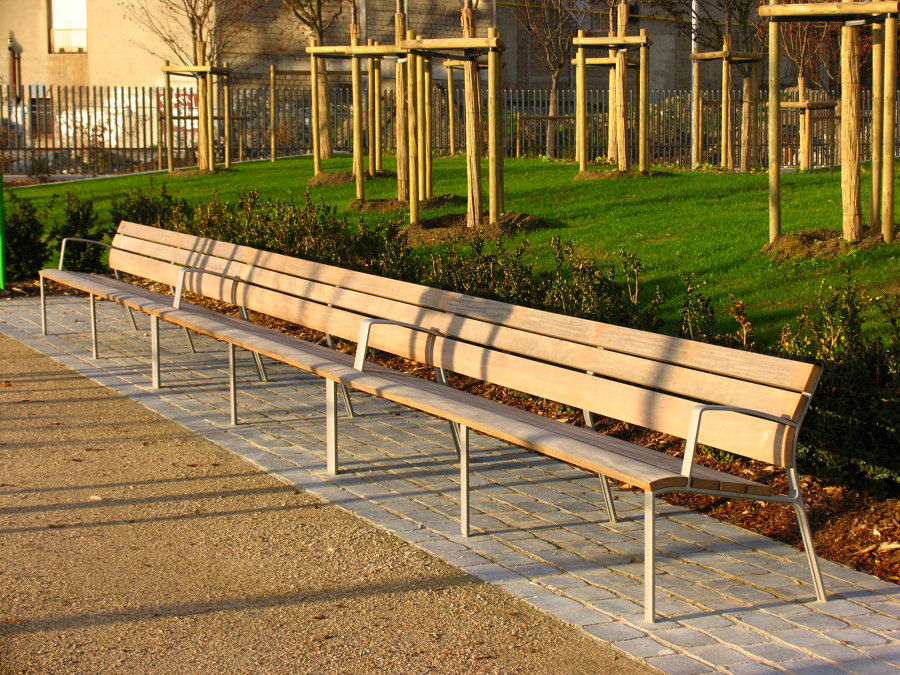
Fotograf: Martin Argiroglo
An ecological park that links neighbourhoods
In 2007, Martin Luther King Park was inaugurated with a focus on sustainable development and optimised energy management, achieved by means of a wind farm and photovoltaic panels, rainwater recovery and waste management. Plants were selected that require little water, fertilisers or insecticides, as well as street furniture elements from Urbidermis, including the NeoRomántico Liviano, Trapecio, Comunitario benches and the Atlántida fountain.
The Clichy-Battignoles Neighbourhood
In 2016, the Clichy-Batignolles eco-neighbourhood was awarded the Sustainable City Grand Prize in the Green City Solutions Awards, demonstrating its innovation in urban landscaping and implementation of environmental technologies. Known under the term eco-neighbourhood, Clichy-Battignoles is located in the north-east of Paris and covers 54 hectares. It includes a total of 3,400 dwellings, suitable for various uses such as residential, family, single-person or shared housing. Clichy-Battignoles has housing capacity for 7,000 inhabitants, with public and cultural services and commercial areas nearby, making it a 21st century neighbourhood.
Martin Luther King Park
A 10-hectare green lung in Paris, Martin Luther King Park is located in the Clichy-Battignoles eco-neighbourhood. Conceived by the landscape architect Jacqueline Osty, together with the town planner François Grether and the engineering firm OGI, it has been developed on the site of the former Batignolles train station, a strategic interconnection point of neighbourhoods in which new urban forms come together with all of their functions and uses: residential, tertiary and leisure.
Its layout expands the city by linking neighbourhoods together, from Epinettes to Pereire, from Batignolles to Boulevard Berthier, and connects the existing riverside green spaces. Martin Luther King Park, created according to rigorous sustainability criteria, defines a space that is self-sufficient in water, waste management and generation of electricity, thanks to the use of solar panels that heat the water and provide the energy required for lighting.
Martin Luther King Park retains the original topography on its western side, where the terraces and ramps match the level required to cross the existing railway line. The landscape qualities blend with the ecological properties of the park, a changing green space that identifies with the changing of the seasons. The park is integrated into the city, meandering harmoniously through a pedestrian route with natural environments that cleverly combine water and vegetation. Sports and leisure areas and trails, playgrounds, open spaces and other more secluded spots with rest areas are created that allow serenity to be enjoyed in the heart of Paris.
In accordance with the prevailing principle of using environmentally friendly elements, the creators of the project selected street furniture edited by Urbidermis due to their design and their FSC® (Forest Stewardship Council) certification, which ensures that the wood used has been harvested and processed according to ecological, sustainable and socially fair and responsible criteria.
The elegance and ergonomics of the NeoRomántico Liviano bench, the robustness of the Trapecio bench, the versatility of the Comunitario bench and the timelessness of the Atlántida fountain are conducive to relaxation and interaction in this great green lung in the Parisian capital.
Architect
Jacqueline Osty et associés, landscapers
François Grether, architect
OGI, BET Llghting consultants
Project Partners
Urbana
Property Owner / Client
SPLA Paris Batignolles Aménagement

Fotograf: Urbidermis

Fotograf: Urbidermis

Fotograf: Urbidermis

Fotograf: Urbidermis

Fotograf: Urbidermis

Fotograf: Urbidermis

Fotograf: Urbidermis

Fotograf: Urbidermis

Fotograf: Martin Argiroglo

Fotograf: Urbidermis

Fotograf: Urbidermis

Fotograf: Urbidermis















